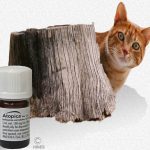Is Atopica® Safe?
Should I Give Atopica® To My Dog Or My Cat?
aka Cyclosporine=Cyclosporin= Ciclosporin=Cyclosporin A
Ron Hines DVM PhD
 Did We Get Chubby On Steroids?
Did We Get Chubby On Steroids?
Atopica® is just one of the trade names for cyclosporin capsules or liquid. Two others are Cyclavance™ liquid and Modulis For Cats™, which has the same formula as Atopica For Cats®. There are many generic and custom-prepared, flavored, forms of the medication available as well.
One of the greatest consternation dog owners face is a persistently itchy and uncomfortable pet. Their skin just wasn’t designed to hold up to hours of licking, chewing and scratching. When that is the situation, it doesn’t take long for your dog’s coat to look moth-eaten and thin. More importantly, your dog’s natural skin barriers that protect it against bacteria and fungus infections are soon breached. When that occurs, dogs develop a typical musty seborrheic skin odor, sores and scabs. It is the itch that comes first – the bacteria, fungi and yeast are just opportunistic freeloaders. (read here & here)
When dog owners and their veterinarians are lucky, scratching is due to a flea problem. Vets and pet owners have very effective medications to eliminate fleas these days. But more likely than not, when fleas are not the primary problem (or only part of the problem) your pet has developed multiple allergies (aka atopic skin disease).
If you are truly fortunate, those allergies will be due to ingredients in your dog’s diet. But contrary to what specialty dog food diet companies would have you believe, the vast majority of itchy dogs itch (= pruritus) for reasons that have nothing to do with what they are eating. And when food allergies are involved, they are likely to be only a small part of your pet’s general allergic predisposition. When food ingredients are the trigger for allergies or sensitivities, the primary target is the intestine (causing diarrhea), not the skin. The much most common form of allergic skin disease in dogs is due to allergies to the ordinary contaminants in your pet’s environment – contaminants that are nearly impossible to eliminate. That said, dogs with tendencies toward multiple environmental allergies almost always itch violently after being bitten by a single flea.
When we humans develop allergies to environmental contaminants, things like pollen, mold, dust mites and the like, the primary target is our respiratory system. We sneeze, our eyes water, our nose is congested, we sniffle. That is because most of the histamines and other mediators that produce inflammation are released by the mast cells present in our respiratory system. (read here) But dogs are different. When they have allergies, these same inflammatory chemicals are released primarily in their skin. That is what causes them to itch. (read here & here)
When veterinarians are faced with allergic (atopic) pets, the first things they often dispense are soothing medicated shampoos and lotions. Itching is a self-perpetuating habit. If your pet’s problem was a one-time thing, if it is relatively minor or if it is seasonal, perhaps those products along with some oral antihistamines will take care of the problem or make it manageable for a time. But with the passage of time, itching problems in dogs that are truly allergic tend to return and gradually become worse. Or itch problems that were once seasonal inconveniences become an all-the-time problem. In those cases, your veterinarian might suggest blood-based allergy testing or one of the many prescription low-antigen diets most vets keep in the back room. Occasionally, that approach is successful – but more often it is not. Referral to a veterinary dermatologist might yield slightly better results.
Perhaps your veterinarian dispensed an oral corticosteroid (e.g. prednisone) or gave your dog a long-lasting corticosteroid injection (e.g. “Depo“). That probably did produce a dramatic improvement. Your dog stopped itching – for a while. But it may have also peed more, ate more and gained weight. When given long-term at a substantial doses, many unwanted but less visible changes can occur as well. That is why your veterinarian was probably reluctant to repeat that therapy, explaining to you about the serious side effects of prolonged corticosteroid use. You probably already knew that anyway. But it breaks one’s heart to live with an unhappy, itchy dog. Your dog is family, and you think about how uncomfortable you would feel. So, you might have talked your veterinarian into repeating the steroid treatment in a skip-a-day dose plan now and then.
All of us veterinarians know that the effects of corticosteroids like prednisone and prednisolone against allergic itching is dramatic. These drugs mimic the effects of your pet’s natural corticosteroid, cortisol, produced throughout the day by its two adrenal glands. Corticosteroids, natural and administered, inhibit your dog’s mast and eosinophil cells from releasing irritating histamine and other cytotoxic compounds (= degranulation) – even when the things in your dog’s environment that it is allergic to are still present. Besides weight gain, prolonged corticosteroid use can lead to decreased strength of the binding protein (collagen) that hold the body together. That decreases the strength of ligaments. Prolonged use also thins the skin, increases blood glucose level and circulating lipid levels (fats). Those things negatively affect your pet’s pancreas and liver. Prolonged corticosteroid use also increases susceptibility to infection. These are only a few of the undesirable things that long-term corticosteroid administration can cause. So, you see why most veterinarians try so hard to give you alternative options in treating allergic skin disease. More has been published about those unwanted side effects in humans than in dogs, but they are no different. (read here, here & here) It is not that corticosteroids are evil drugs. There are critical uses for them in dogs and cats. Dogs with many forms of lupus (autoimmune disease) have very few alternative medications to help them. Corticosteroids can be life-saving during episodes of anaphylaxis and other forms of shock. When corticosteroids are included in the topical sprays and lotions your veterinarian dispenses for your dog’s skin, it is because he/she hopes that less of the medication eventually reaches your pet’s blood stream where it might cause systemic (whole body) side effects (e.g. beclometasone). When corticosteroids are included in the drops and ointments your veterinarian prescribes for ear infections, they relieve pain, decrease inflammation and swelling and prevent self trauma long enough for the antibiotics in the products to do their work.
What is Atopica®?
The lack of options other than corticosteroids for the long-term control of canine allergic dermatitis or atopy led Novartis Pharmaceutical Co (now an Elanco product) to apply for an FDA permit to market cyclosporin for canine itching under the trade name, Atopica®. That request was approved in 2003.
Cyclosporin is a compound that occurs naturally in a certain fungus. While searching for new antibiotics in 1969, Sandoz discovered the fungus growing in soil samples from Norway. Fungi often produce novel antibiotics (e.g. penicillin) to defend themselves against competing bacteria and fungi. Sandoz did find that cyclosporin did have weak antibiotic properties; but not enough to market the drug for that use. However, they noticed that cyclosporin was also immunosuppressive in laboratory rodents. It disabled T-lymphocytes, which helped prevent rejection of transplanted organs. (read here) Until then, corticosteroids and some rather toxic compounds were all that physicians had. Later, it became useful in treating a wide variety of autoimmune diseases in people (due to their out-of-control immune system).
How Does Atopica Work?
All allergies are immune system mistakes. Sentry cells in your dog’s immune system have mistaken something harmless in its body or in its environment for something dangerous. The system consists of a large number of different cell types, transmitter chemicals that interact in ways which are not fully understood. Here is my simplified explanation:
Allergies are caused by unnecessary antibodies – antibodies your dog produces against compounds in its environment (like mold, house, dust mites or pollen) that would ordinarily be ignored. Your dog itches because those antibodies cause mast cells in its skin to release histamines (other cells of your dog’s immune system become involved too). Those histamines and related compounds produce inflammation that irritates the nerve endings in your dog’s skin. Mildly irritated nerve endings cause itching. Severely irritated nerve endings cause pain. Neither cause the skin damage, hair loss and secondary skin infections that you observe – your dog does that to itself by scratching and chewing.
Cyclosporin (Atopica®) interferes with this extremely complex process. It prevents a certain specific group of lymphocytes (immune system cells) the helper T- lymphocytes, from transmitting chemical messages (calcineurin / interleukins) that result in histamine release from your dog’s skin mast cells. Without released histamine, your pet does not itch. You can think of helper T-lymphocytes as the policemen of the body – always looking for intruders and blowing their whistles when they find them.
Will Atopica® Stop My Dog From Itching And Scratching?
Yes.
Cyclosporin is usually just as effective as corticosteroids in reducing inflammation and stopping itch.
The drug is sold in four-size capsules. It is recommended that they be given to your dog on an empty stomach. Veterinarians generally dispense cyclosporin for daily use until substantial improvement in the itching is noticed (about 3-6 weeks). When that happens, your pet’s dose frequency is reduced to every second day. If that is still sufficient in stabilizing your dog your veterinarian might try to give Atopica® even less frequently – perhaps every 3–4 days. Not all dogs absorb Atopica® or maintain blood levels of the drug equally well. Some veterinarians follow the drug’s blood levels with periodic blood tests and adjust your dog’s dose schedule accordingly. That is a good way to determine your individual dog’s drug metabolism. But other vets do not believe that blood levels accurately predict concentration of the medication in the skin itself and make their adjustments based on the positive response you, and they see (less itching, improved skin). I am in the second group.
Does Atopica® Have Less Long-Term Side Effects Than Corticosteroids Like Prednisone?
No.
Although there are dogs, like people, who handle one medication better than another, the potential long-term side effects of Atopica® are at least as severe as those of corticosteroids. They are just different side effects. These side effects might take longer to occur, and they might not be as readily apparent to you at first. You can read about some of those serious side effects when they occur in humans at the FDA website. When given to cats subsequent to a kidney transplant, the odds of them developing cancer were increased by 18.3%. (read here) The three most worrisome side effects associated with cyclosporin in pets and animals are liver and kidney damage and an increased incidence of cancer. It appears that the lower the dose and the more infrequently the drug is given, the lower the chances that any of these will occur.
It is not at all clear that your dog or your cat will do any better long-term on Atopic/cyclosporin than it would on a wisely-thought-out program of intermittent corticosteroid (prednisone, etc.) use combined with less severe options that include topical products, nutritional management and physical intervention. (read here) Dogs receiving cyclosporin are considerably less likely to gain weight and retain fluid than those receiving corticosteroids. But veterinarians and dog owners have quite a few options in dealing with overweight dogs (read here) and very few options when it comes to kidney disease, liver disease or cancer.
Can You Tell Me More About These Specific “Dangers” You Mentioned?
The Potential Immediate Side Effects
The majority of dogs that receive a proper Atopica® dose do not experience any noticeable side effects. About 30% do experience vomiting, loss of appetite, GI upsets or diarrhea. When your pet begins the drug, if you start the first week at a lower than label-suggested dose, you can often avoid those issues. If not, immediate side effects, when they occur, often lessen or disappear after the dog has been on the medication for a week or two. Since most dogs seem to handle the drug just fine, owners are usually quite satisfied with their pet’s lack of itching and the lack of the weight gain and frequent urination that often accompanies corticosteroid use. Atopica® can, on occasion, cause inflammation of skin and gums So some dogs develop thickened, swollen gums (epulis, gingival hyperplasia). (read here) Others develop reddened or tender ear flaps and some develop thickened foot pads (calluses, epidermal hyperplasia, hyperkeratosis). Other dogs appear to shed more hair while on cyclosporin.
The Potential Long-term Side Effects Of Atopica®
Veterinarians like myself have no problem telling you what the immediate potential side effects of Atopica® are. When they occur they are quite obvious and can often be managed by decreasing the dose or extending the period between doses. It’s harder for us to tell you what the long-term consequences of keeping your pet on a powerful drug like cyclosporin might be. That is because as time goes by, health events often occur, and it is next to impossible to be sure that a new or worsening health issue is related to the cyclosporin. I mentioned that allergies are faulty decisions made by your dog’s immune system. Immune systems prone to one judgment error might be prone to another without Atopica playing a part. But since the drug was introduced in 1983 by Sandoz/Novartis to human medicine as Neoral®, there is already a larger body of information on its long-term side effects in humans and there is no reason to believe that these documented side effects would be very different in dogs. That is why many of my reference links and warnings are based on human studies – not dog studies that have never been performed.
I explained earlier that Atopica® works by toning down (reducing) the activity of your pet’s whole immune system. That, unfortunately, is a double-edged sword. The same helper T-cell policemen that I told you about earlier – the ones whose activities are disrupted by Atopica®, are also the officers that patrol your pet’s body for invading bacteria, other pathogens. More concerning to me, these are the same policemen cells that keep a lookout for abnormal body cells – the ones that might later give rise to cancer. Atopica is not at all selective as to which helper T-cell job or activities it blocks. It blocks them all. None of the drugs in the cyclosporin/Atopica class generate cancer. But they all weaken the portions of the immune system that are responsible for nipping cancers in the bud. We and our dogs all give rise to occasional mutant (precancerous) cells. Cells with DNA errors. Most biologists believe that a vibrant (strong) immune system usually detect and destroy these mutated cells before a tumor can form.
Potential Effects On Your Pet’s Kidneys
A second potential problem with Atopica® is that the calcineurin messenger compounds that cyclosporin blocks are also found in your pet’s kidneys. So Atopica® has the potential to damage the kidneys as well. You can read about that here.
Potential Effects On Your Pet’s Liver
Cyclosporin appears to also have the potential to injure the liver. The liver is a very vascular (blood-filled) organ, and cyclosporin has negative effects on microcirculation in many organs. (read here & here)
Ear Infections
An increase in the number of ear infections (otitis externa) appears to occur in dogs receiving cyclosporin/Atopica®. It is hard to sort out why that might be. Most dogs with chronic skin allergies already have associated ear problems. It could be that rather than causing the problem, cyclosporin only weakens the pet’s natural immune defenses that are keeping those infections at bay. Whether the swollen ear flaps sometimes seen with the drug’s use are due to its effect on skin or reactivated ear infections and increased ear scratching is unknown.
Increased Number Of Tumors
I already mentioned that cyclosporin is known to increase the incidence of cancer in humans. (read here & here) As dogs age, they too develop abnormal, precancerous cells throughout their bodies – we all do. We all rely on those immune system policemen cells to locate those precancerous cells and destroy them through a process called apoptosis. Dogs and humans receiving cyclosporin are not as effective in doing that. (read here) Novartis acknowledges that dogs on Atopica® run a greater risk of developing cancers. They explain that as the drug’s ability to “exacerbate subclinical neoplastic conditions”. But they give no explanation as to how they came to the convenient conclusion that no really new tumors were formed.
Leukemias and lymphomas are lymphocyte tumors. They increase in frequency in humans receiving cyclosporin. There are reports that lymphomas increase in frequency in dogs receiving cyclosporin as well. Novartis reported to the FDA that the lymph nodes of dogs receiving Atopica® became enlarged in 2.3% of the dogs receiving the drug for 28 days. Lymph node enlargement (lymphadenopathy), when not related to infection, is often a prelude to lymphoma.
Effect On Blood Capillaries
I mentioned earlier that cyclosporin has the potential to cause injury to the lining of small blood vessels found throughout your pet’s body. (read here) That is sometimes referred to as its potential for “vasculotoxicity”.
Increased Susceptibility To Infections In General

Dogs and humans receiving cyclosporin appear to have reduced ability to fight infections of all kinds. That includes bacterial and fungal skin infections and urinary tract infections. Your dog or cat can have infections and parasites that you and your veterinarian are not aware of – but that are being kept under control by the pet’s healthy immune system. If you weaken that system with medications like cyclosporin/Atopica®, the animal’s body can lose its ability to keep the situation under control. Toxoplasma is one of those parasites, you can read about what happened to two cats when they were given cyclosporin here. You can read another report of the worrisome number of side effects associated with the use of this drug in cats here.
Neurotoxicity
Some dogs receiving Atopica® appear weaker than usual – particularly in their hind legs. It is very hard to judge the causes of generalized weakness in pets. Sometimes a dog’s just not feeling well can be misinterpreted as weakness. But cyclosporin is known to occasionally produce muscular weakness and nerve dysfunction in human beings, so perhaps in our pets as well.
Potential Effects On The Pancreas
Cyclosporin also has the capacity to lower your dog’s ability to produce insulin, and in doing so, interfere with blood sugar metabolism. (read here)
Increased Number Of Warts (papillomas)
Veterinarians have noticed that some dogs receiving Atopica® grow more warts. Warts on dogs are benign skin tumors caused by a virus (the canine papillomavirus). (read here) Some believe that liberation of this same virus might even be involved in the other skin thickening and inflammation problems occasionally seen in dogs receiving cyclosporin (read here)

What Should I Do?
As you probably already guessed, I am not a fan of this drug. I see few, if any, advantages in giving your dog Atopica®/cyclosporin over giving it periodic and carefully monitored corticosteroids. Both offer equal relief. They just differ in their major negative side effects. Those side effects can be substantial when giving either drug too frequently or in large amounts. Topical anti-itch shampoos require a lot of time and effort on your part, but they offer quite a bit of itch relief that often allows oral medications to be given only seasonally or at a lower dosage.
If that does not appeal to you, my suggestion is that you explore giving your dog Cytopoint® rather than Atopica®, Apoquel® or extended periods on corticosteroids. Cytopoint® interrupts the itch cycle in a more focused and precise way than either Atopica or corticosteroids. My feedback from dog owners that use Cytopoint® had been generally good, it has now shifted to be more negative. Read that owner feedback here, but remember that more people are motivated to write to me more often when things go wrong than when things go well.
Can I Use Less Expensive Generic Drugs Similar To Atopica®?
Naturally, Novartis/Elanco does not like that idea. You can contrast their drug reps statements with those of the FDA here. There is no published data that I know of comparing the two products. Virbac now offers their own brand of cyclosporin, Cyclavance™. But many pet owners seem equally satisfied with the results they obtain from the generic and the name-brand forms, and many people who have had kidney transplants trust their lives to the same generic cyclosporin.
Are There Dogs Where Cyclosporin Might Be My Best Choice?
Yes. There are dogs that do not respond to Cytopoint®. Some of those dogs will respond to prednisolone or prednisone however, steroids such as those often cause excessive weight gain and other troublesome side effects. In those dogs, cyclosporin given every two to three days during summer allergy peaks, and perhaps as little as twice a week in winter might be effective. It often works best when combined with a 0.015% triamcinolone topical spray (e.g., Genesis®). Topical corticosteroid sprays such as these tend to produce less unwanted side effects and are effective at a lower dose than corticosteroids given orally or by injection. (read here) Diet ingredient alterations in combination with medications are worth trying as well. It often takes several months to notice improvements related to diet change. When taking cyclosporins such as Atopica® be on the lookout for gum growth (gingival hyperplasia). Having your pet’s urine checked at 2 months and then every 6 months for bacteria and its blood alkaline phosphate level and WBC count are other wise choices.
Are There Dogs In Which Atopica® Should Be Used With Considerably More Caution Than Others?
Atopica should be used with caution in all dogs. But since the drug is removed from your pet’s body by its liver, I believe that dogs with liver disease or elevated liver markers (ALT, AST, GGT, bilirubin) should not receive it. Nor would I use Atopica® in dogs with even the slightest evidence of kidney disease (elevated BUN, and/or creatinine), heart disease, certain blood disorders or cancers.
As I mentioned, that because kidney damage is the most frequent serious side effect in humans taking cyclosporin, it would be wise to periodically have your dog’s urine and blood checked to keep tabs on its kidney function. I mentioned the standard tests, BUN and creatinine. However, by the time those values rise, a pet’s kidneys are already severely damaged. The two tests that detect kidney damage earliest are the urine microalbuminuria test and the urine protein:creatinine ratio. These are the same monitoring tests suggested for humans taking cyclosporin. SDMA results are too erratic to be of much help.
Those are my personal feelings. I am by nature a cautious person. There are many veterinarians whose approach would be different from mine.
What Should My Veterinarian Monitor While My Pet is Taking Atopica®?
I suggest that your veterinarian run the blood tests I just mentioned before dispensing Atopica® to be sure it does not have any hidden kidney, liver or heart problems or evidence of early cancer. Then that your veterinarian monitor your pet’s kidneys, liver and heart and general health and wellbeing while it is on the medication. You need to be aware that negative effects of cyclosporin sometimes appear in humans long after the drug was discontinued. I would suggest that blood tests be run one month and two months after the first dose to screen for acute problems, and twice a year thereafter. Again, that’s just a personal suggestion, you or your veterinarian might be more comfortable performing those tests more frequently.
Checking for the potential of cancer or its exacerbation (worsened) is much harder. Novartis hints that when cancer occurs in pets taking Atopica®, it only speeds the growth of cancers that were already present. That is not based on any scientific information I am aware of. Veterinarians and physicians do not have screening tests, short of biopsies from every organ, that might detect early cancer. About the best we can do is monitor your pet’s superficial lymph node size, and check its blood for the presence of any abnormal cells (Preleukemic syndrome). That only directly detects tumors of the lymphatic system and blood. Periodic x-rays or ultrasound examinations might also be helpful in select cases. Unexplained loss of healthy body weight is never a good sign.
You are on the Vetspace animal health website
Visiting the products that you see displayed on this website help pay the cost of keeping these articles on the Internet.




